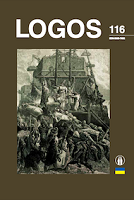Dailininkas Mykolas Elvyras Andriolis
Artist Michael Elviro Andriolli
Author(s): Michał Elwiro AndriolliSubject(s): Visual Arts, Aesthetics, Sociology of Art
Published by: Visuomeninė organizacija »LOGOS«
Keywords: Michael Elviro Andriolli; graphics; painting; illustrations; romanticism;
Summary/Abstract: The artist MICHAEL ELVIRO ANDRIOLLI (Michał Elwiro Andriolli 1836–1893) was born in Vilnius in the family of the Italian sculptor Francesco Andrioli and the local noblewoman Petronella Gośniewska. Francesco Andrioli was a participant of the Napoleonic campaign of 1812. In 1855, due to his father's wishes, Michał Elwiro Andriolli began to study medicine in Moscow, but soon switched to art studies at the School of Painting, Sculpture and Architecture under Prof. Sergei Zarianko. This did not satisfy the ambitious young man and, after living with his parents in Vilnius, he went to Rome in 1860 to continue his studies at the prestigious St Luke's Academy. Returning to Vilnius in 1861, he became involved in cultural activities, as well as in the organisation of the 1863 Uprising. He himself took part in it, fought in the forests of Paneriai and Rūdininkai, and was wounded near Dubičiai. After the Uprising was suppressed, he was persecuted and went into hiding in Vilnius, Kaunas, Moscow and St. Petersburg. However, he was arrested there and brought to Kaunas prison. He managed to escape from the prison and went abroad. 1864-1866 the artist lived in London and Paris engaged in artistic activities, but his rebellious mood did not leave him. Unable to return to his country legally, he attempted to cross the border under an assumed name but was arrested. In 1868, M. E. Andriolli was convicted by the Vilnius Military Court and exiled to Viatka. In 1871, he was amnestied, but without the right to live in Lithuania.The further creative environment of the artist was connected to Warsaw and Paris. Although the exile significantly disrupted his career as an artist, nevertheless, being very hardworking and talented, he soon established himself as an unsurpassed illustrator, who actively collaborated in the Polish press („Tygodnik Illustrowany“, „Kłosy“, „Biesiada Literacka“, etc.) and created several memorable series of illustrations for the works of Adam Mickiewicz, Józef Ignacy Kraszewski, Władysław Syrokomla, Eliza Orzeszkowa, Antoni Malczewski and other writers. Hoping to expand his creative field and, of course, to have more career opportunities, he went to Paris in 1883, where his expectations were fulfilled. Famous French publishing houses competed for the opportunity to sign a contract with the extremely productive illustrator. He mostly worked on behalf of the Firmin Didot publishing house, illustrated the works of world classics James Fenimore Cooper, Victor Hugo, William Shakespeare, Alexander Dumas, Walter Scott, and also published works in the newspapers "Le Figaro", "L'Illustration". However, he felt homesick and longed for a calmer life, so M.E. Andriolli returned to Brzegi (near Warsaw) in 1886 and continued to engage in his favorite creative activities.The artist's works are spread throughout Lithuanian, Polish, Russian museums and private collections. Many of his works were burnt down in a fire in his workshop in Brzegi in 1883. In Lithuania, the part of his work that recalls the country's legendary past, the history of the Grand Duchy of Lithuania, the times of the nobility's prosperity, and the events of the 1863 uprising is quite widely known. For Lithuania, his legacy in the field of religious art is also significant, with paintings created for the Kaunas Cathedral of Apostles St. Peter and St. Paul, the Kaunas Church of St George the Martyr, and the Veliuona Church of the Assumption of the Blessed Virgin Mary. M. E. Andriolli's creative style is characterized by a light, lively performance, evocative drawing and a sometimes somewhat theatrical treatment of the plot, with tendencies towards Romantic heroisation.
Journal: LOGOS - A Journal of Religion, Philosophy, Comparative Cultural Studies and Art
- Issue Year: 2023
- Issue No: 116
- Page Range: 87-93
- Page Count: 7
- Language: Lithuanian

